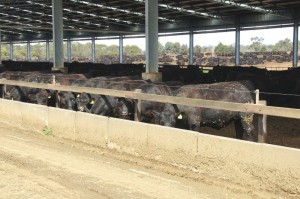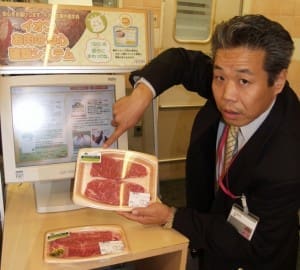Location: Powranna, Tasmania
Operating capacity: 13,000 head
Turnoff 2014: 20,000 head (est)
2003 Top 25 ranking: Was not identified (perhaps listed as No 22 “Name and address withheld” with a capacity of 9000 head.)
AS the only commercially-significant feedlot in the island state, the Japanese-owned Tasmania feedlot last year celebrated its 40th anniversary as a supplier of high quality Australian grainfed beef into Japan.
Although it has a licensed and built capacity for 16,000 head, the fact that the facility primarily feeds longfed Angus out to about 180 days to meet Japanese tastes for well-marbled beef means that it’s operating capacity, in practise, is limited to about 13,000 head. A feedlot’s capacity license is based on shortfed export cattle around 600kg in weight, meaning anything fed beyond that reduces a feedlot’s effective operating capacity.
During the last Top 25 industry survey carried out in 2003, Tasmania feedlot was rated at 9000 head, but again, that may have been overstated, based on licensed capacity, rather than longfed operating capacity.
Located at Powranna, south of Launceston, Tasmania feedlot is unique, for a number of reasons:
- It is easily Australia’s southernmost feedlot, and is the only commercial-scale feedlot in Tasmania
- Infrastructure includes permanent shedding for 2000 cattle – easily the largest capacity among Australia’s small number of feedlots that use permanent shed structures, as opposed to shadecloth cover.
- Another factor setting the Tasmania feedlot apart is its high average annual rainfall – possibly the highest of any feedlot location in Australia, at more than 660mm – and low evaporation, which is the underlying reason for the original investment in shedding.
- The ration utilises large quantities of potato peelings, drawn from a nearby chip processing factory, and spent brewers grains, from Launceston’s historic Boag’s Brewery.

Part of the extensive permanent shedding infrastructure used at Tasmania feedlot. Click on image for a larger view
Shedding is employed in the finals stages of each animal’s feeding program, for a variety of reasons. Combined with the woodchip/sawdust bedding, the dry conditions greatly reduces dag-load prior to slaughter, while also delivering improvements in weightgain performance, both summer and winter.
The latest of three 120m x 240m sheds installed last year at a cost of $1 million is anticipated to have a payback period of just three to five years in productivity and management benefits.
Cattle carrying heavy dag burdens can suffer heavy cost penalties at the meatworks from having to shear ‘cut lines’ before slaughter to lessen the risk of bacterial contamination from dags during the manufacturing process.
An important secondary benefit from the shed installations comes in cattle comfort. Winter temperatures in the sheds are 5-6 degrees C warmer than outside pens, and summer temperatures are 5-6 degrees cooler. Cattle typically put on another 100 grams (0.1kg) per day in ADGs, across both summer and winter cycles due to lack of exposure to wind and cold temperatures in winter, and shade during the hotter months.
Another handy ‘by-product’ of the shed facilities is the ability to harvest the water off the roofs. This produces about 45 megalitres of potable stockwater each year – a significant resource, when capital cost to supply water in Tasmania can cost $1000/Ml.
All of the bedding material and pen waste removed at cleaning is composted and sold for nursery and landscaping use.
Almost the entire cattle turnoff, processed through the nearby JBS Longford and HW Greenham Smithton plants, goes into parent company, Aeon’s huge Jusco supermarket chain in Japan.

Each pack of beef from Tasmania feedlot in Aeon’s Jusco supermarkets has a bar code providing traceability back to individual animal level, feeding history and feedstuffs used, property of origin, processing location and date of processing.
The product on-shelf in the Jusco supermarkets proudly proclaims its Tasmanian heritage. Jusco supermarkets in Japan are renowned for developing and operating some of the most comprehensive individual animal traceability systems in the retail beef world.
Dry conditions across Tasmania last year saw the feedlot used for some custom-feeding for outside customers including Greenhams, mostly domestic weight British-type heifers. This tends to be done on an opportunity basis, when demand and space allows.
Feeder cattle are all straightbred, high-performance Angus steers procured from a network of regular suppliers across the Tasmanian ‘mainland’ plus Flinders and King Islands.
The standard feeding program for the Aeon/Jusco supermarkets program is 165 days, minimum marbling score of 2, but with many now hitting scores of 3-4 with growing consistency. Barley is the primary grain component, plus lucerne and cereal straw, and the by products mentioned above. Carcase weights average 360-370kg across the yearly cycle.
Another big advance made four years ago was a grain processing move from dry-rolling to steeping, raising grain moisture levels to 20pc before rolling, which is delivering substantial productivity benefits in grain utilisation.
In no small way, the demand signals from the feedlot have been a major contributor to Tasmania’s beef cattle genetic profile ‘turning black’ over the past 20 years.
This feature is brought to you by Lallemand Animal Nutrition.
- Click here to return to Top 25 Lotfeeders table.
- Click here to return to Top 25 Lotfeeders introductory article.
